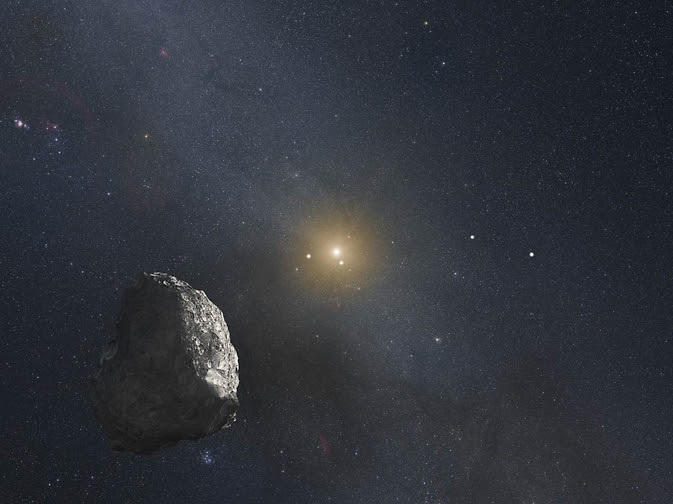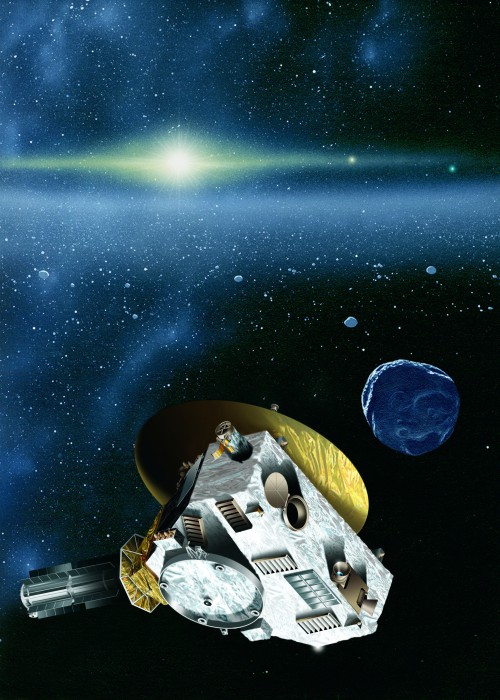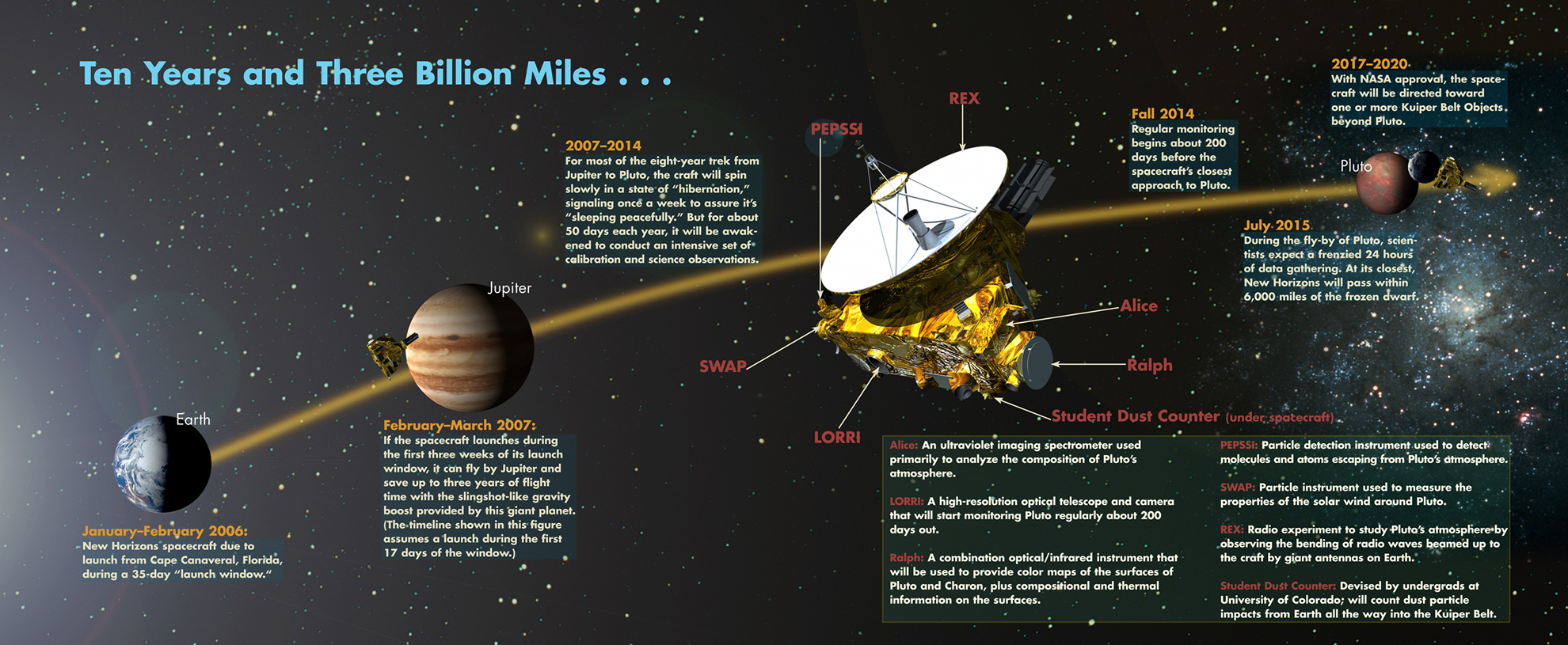
Image Credit: NASA, ESA, and G. Bacon (STScI)
Excitement is building as one of the most anticipated missions this decade gets closer and closer to providing the world with our first up-close views of a place so far away that humanity has never seen it in any real detail. For nearly eight years New Horizons has been blazing a trail across the Solar System, and with it recently crossing the orbit of Neptune the spacecraft is now in the final stretch of its primary objective, aiming for a July 2015 encounter with the only world not yet visited by humanity’s robotic explorers, Pluto. But the spacecraft won’t be able to slow down enough to stay and enjoy the view; Pluto’s gravity is so weak, and New Horizons is traveling so fast, that the spacecraft has no room for the extra fuel that would be required to go into orbit. Instead it will fly by Pluto at nearly 9 miles per second (over 30,000 mph), giving the science team back on Earth one shot at collecting all the science data and imagery they can.
Beyond Pluto, however, lies an area with more objects than the rest of the Solar System has combined, objects that are deep-freeze time capsules from the birth of the Solar System itself, the left-overs from over 4 billion years ago. It is the Kuiper Belt, and this week NASA announced that the Hubble Space Telescope has identified three new deep space Kuiper Belt Objects (KBOs for short) that are potential candidates for New Horizons to explore after it leaves Pluto in the rear view mirror next summer.

“This has been a very challenging search and it’s great that in the end Hubble could accomplish a detection – one NASA mission helping another,” said Alan Stern of the Southwest Research Institute (SwRI) in Boulder, Colo., principal investigator of the New Horizons mission.
According to NASA, the three new KBOs discovered by Hubble are each about 10 times larger than typical comets, but still much smaller than Pluto or any of its moons (only 1-2 percent of the size of Pluto). Using its Wide Field Camera 3 (WFC3) and Advanced Camera for Surveys (ACS), Hubble revealed that two of the KBOs are estimated to be as large as 34 miles across, with the third perhaps as small as 15 miles, and each lies an estimated one billion miles beyond Pluto. However, unlike previous observing campaigns that could not find a KBO within reach of the spacecraft, the most recent observations done with Hubble between July and September of this year show that one of the newly discovered KBOs is considered “definitely reachable.”
Finding a KBO to explore that is within reach of New Horizons is like looking for a tiny dim needle in a giant haystack full of stars in the constellation Sagittarius, because that is the direction the spacecraft is traveling. The New Horizons team has searched several times since 2011, using ground-based telescopes such as the twin 6.5-m Magellan Telescopes in Chile and the 8.2-m Subaru and 3.6-m Canada–France–Hawaii Telescopes on Mauna Key in Hawaii to hunt for any KBOs with orbits close enough for the spacecraft to study as it hurtles through deep space. Pluto and any neighboring KBOs are easily lost in the intense glare coming from the densely packed stars of the galactic core of our Milky Way, where Pluto is presently positioned relative to Earth’s point of view.
In addition, ground-based telescopes have to contend with the blurring effects of the Earth’s atmosphere, which further hamper the search for objects as small as 30 miles across and as dark as charcoal, observed from a distance of more than three billion miles away. The New Horizons science team has also proved to be overly optimistic in its previous estimates of the number of very small objects that could lie in the Kuiper Belt, which turned out to be fewer than expected.
The mission’s team requested to be allocated a small amount of observing time with the superior resolving power of Hubble in October 2013, and after weighing in the scientific merits of their application the Space Telescope Science Institute’s Hubble Space Telescope Time Allocation Committee finally announced their decision to allow the New Horizons team observing time to search for suitable KBOs last June.

A two-fold observing campaign was conducted by Hubble to support the search for KBOs that New Horizons could potentially explore, due to the extremely limited amount of available observing time on the space telescope, compared with the observing time requested by the plethora of applications from the astronomy community each year. For the first part of the observing campaign Hubble used 40 orbits (2.5 days of observations) to turn in such a way as to match the predicted rate with which KBOs are moving across the sky. This way the telescope’s cameras could depict the stars in a total of 20 different star fields as streaks in the resulting images, whereas any KBOs would appear as pinpoints of light.
Those preliminary observations aimed to prove Hubble had a statistically strong chance to find a pair of KBOs for New Horizons to visit, by mapping the number of KBOs in the region near Pluto. With the pilot search proving successful, the Space Telescope Science Institute allocated the mission team another 156-160 Hubble orbits in order to conduct a more thorough set of observations that eventually succeeded in identifying New Horizons’ potential future targets following the Pluto encounter.

“We started to get worried that we could not find anything suitable, even with Hubble, but in the end the space telescope came to the rescue,” said New Horizons science team member John Spencer of SwRI. “There was a huge sigh of relief when we found suitable KBOs; we are ‘over the moon’ about this detection.”
Once New Horizons completes its primary mission with Pluto in 2015, NASA will conduct an extensive science and technical review to determine whether extended operations are warranted, and the New Horizons team expects to submit such a proposal to the space agency in 2016 to fly by one of the newly identified KBOs. If history is any indication, NASA will most certainly agree with the mission’s science team, because exploring a KBO would substantially increase the science return from the New Horizons mission, as laid out by the 2003 Planetary Science Decadal Survey.
With each of the three discovered KBOs that New Horizons might be able to visit being located one billion miles beyond Pluto, any KBO flyby would not occur until sometime between 2018 and 2020, because the spacecraft will take 3-4 years to travel another billion miles across the outer Solar System to reach them.
The spacecraft is currently in hibernation, its final slumber before awakening again on Dec. 6 to begin preparations for its encounter with Pluto, observations which will begin six weeks later. The mission team conducted their eighth and final “pre-Pluto” spacecraft and payload Active Check Out this summer. During that time the team also conducted the spacecraft’s first course-correction since 2010, which refined the spacecraft’s trajectory so accurately that the mission team determined there’s no need for any new trajectory correction before at least March 2015, and possibly later, which eliminates the need for a planned January burn completely. That’s good news for potential KBO exploration, as any such extended missions will be heavily dependent on whatever fuel the spacecraft has remaining.
The team also uploaded the final autonomy system software for the Pluto encounter this summer, checked out all seven payload instruments, conducted some final instrument calibrations, and performed the first optical navigation campaign to home in on Pluto using New Horizons’ Long Range Reconnaissance Imager (LORRI).
New Horizons’ closest encounter with Pluto—the day the world gets its first up-close views of the tiny world three billion miles from home—will occur on July 14, 2015, when it passes just 6,000 miles above the surface at over 31,000 mph.
– Article written by both Mike Killian and Leonidas Papadopoulos
Want to keep up-to-date with all things space? Be sure to “Like” AmericaSpace on Facebook and follow us on Twitter: @AmericaSpace




PHEW! Given that there is only nine months to go until New Horizons’ encounter with Pluto and the quickly narrowing trajectory options of where to go afterwards, I was willing to wager that a suitable target for a close encounter would not be found at such a late date. Still, given the huge number of targets with an apparent range of characteristics beyond Pluto as well as the inevitable questions New Horizons will raise next year about Pluto and its moons, now is the time to start thinking about a follow on mission to this distant world.
http://www.drewexmachina.com/2014/07/14/the-next-mission-to-pluto/